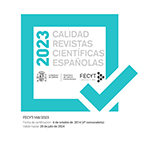Compeled Identities in Gender Violence: the Simulated Victim
Abstract
In the contemporary world ‘being a victim’ has become a more widespread condition. In the last years in Spain, the victim of gender violence has turned into a central position among all other victims. The woman who suffers gender violence is assisted by a specific law, this has led to a highly institutionalized treatment of the victim, which includes specialized police units, courts, forensic scientists, social workers and psychologists, among other. After interviewing, mainly, women who have, first, suffered abuses and, after, received institutional support, it was found that, what defines the gender violence victims of gender as a social figure, is not the set of suffered aggressions, neither their degree of subjective suffering, but the institutional response to their situation: the way the activated institutional practices and assistance instruments shape the victims’ identities. Three milestones can be identified in the institutional itinerary of victims of gender violence: the revelation, the agency and the simulated life. The victim is supervised by different institutional mechanisms and protocols under the principe of a moral mandate: she has to stop being a victim. In a paradoxical tension she is pushed to identify herself as a victim to leave this position inmediately, an identity lived as a moment of passage, she must empower herself by taking awareness of her situation. In this institutional context the gender violence victim has to perform, according to the non written patterns, a credible –or good– victim: one that accepts being rescued from herself.Downloads
Article download
License
In order to support the global exchange of knowledge, the journal Política y Sociedad is allowing unrestricted access to its content as from its publication in this electronic edition, and as such it is an open-access journal. The originals published in this journal are the property of the Complutense University of Madrid and any reproduction thereof in full or in part must cite the source. All content is distributed under a Creative Commons Attribution 4.0 use and distribution licence (CC BY 4.0). This circumstance must be expressly stated in these terms where necessary. You can view the summary and the complete legal text of the licence.











